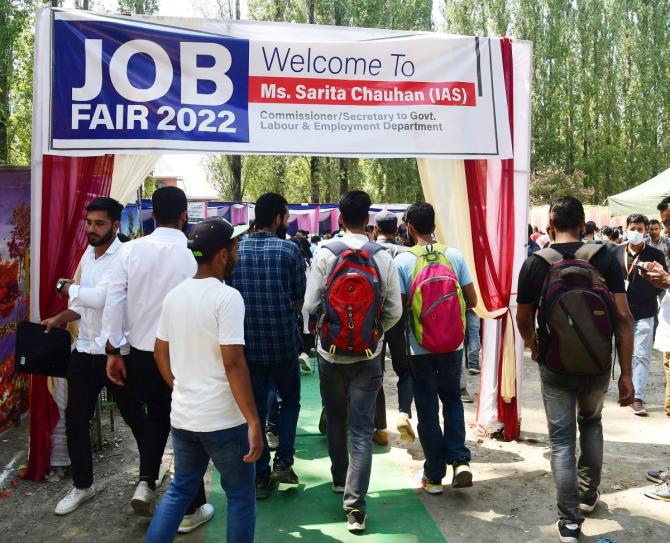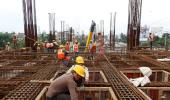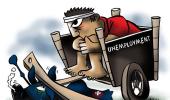The country's demographic dividend is dissipating, with seriously adverse consequences for young India, asserts Shankar Acharya, former Chief Economic Adviser to the Government of India.

India's population is still young, with about 55 per cent below 30 and over a quarter below 15.
Its billion-strong working age population embodies an enormous potential for jobs and economic growth.
About 19 years ago, I had warned that this demographic dividend could be squandered in the absence of right policies.
Since then, successive governments have persisted with wrong or weak policies and programmes, including a poor public education and skilling system, an extremely complex and anti-job-creating maze of labour laws and regulations, foreign trade and exchange rate policies that discourage labour-using exports and import-competing domestic production, weak infrastructure that undermines productivity and connectivity and avoidable policy shocks like demonetisation.
The Covid pandemic hasn't helped. There is mounting evidence that the dividend is dissipating, with seriously adverse consequences for young India.
Mahesh Vyas, the head of the Centre for Monitoring the Indian Economy (CMIE), has pointed out that according to World Bank data, the employment rate (=number of employed divided by the population in the corresponding age category) for the 15-24 age group was a low 23.2 per cent in India in 2020, compared to 50.6 per cent in North America, 42 per cent for OECD countries as a whole, 38.9 per cent in Pakistan and 35.3 per cent in Bangladesh.
What's more, the same data set showed that the employment rate for the 15-24 category had fallen a lot over time in India from 43.4 per cent in 1994 and 40.5 per cent in 2005 to 23.2 per cent in 2020.
Vyas notes that the World Bank data rely on national, official statistics, 'that have a rather relaxed definition of employment, following ILO guidelines'.
The CMIE's own survey data 'follow a more stringent definition of employment', according to which the employment rate for this age group fell steeply from 20.9 per cent in 2016-2017 (the first year of this survey) to a dismal 10.4 per cent in 2021-22.
That is, just over a mere tenth of this youth group was employed in 2021-22! For the common year of 2020-2021, the CMIE ratio, at 10.9 per cent, is just under half the 23.2 per cent seen in the World Bank data.
Let us now turn to the official data (with its 'relaxed definition of employment') from the National Statistical Office (NSO), formed by the merger in 2019 of the earlier National Sample Survey Office and the Central Statistical Office.
These surveys were periodic (every 5-7 years) till 2017-18.
Since then they (Periodic Labour Force Surveys) have been annual (July-June year) with the latest published for 2020-21.
The readily available youth group data from this source refers to 15-29 years, which is a wider and, in some ways, better depiction of youth.

According to these official data, the employment rate for youth again shows a similar pattern over time, slumping from 53.3 per cent in 2004-2005 to the low 30s from 2017-2018 onwards, barring a marginal uptick in Covid-hit 2020-2021 (please see below).
The same data also show a disturbingly sharp rise in the rate of open unemployment among youth, tripling from 5-6 per cent in 2004-2005 and 2011-2012 to 17-18 per cent in 2017-2018 and 2018-2019.
There is a modest, counter-intuitive decline in 2019-2020 and 2020-2021, which can be attributed to the observed, significant increase in the share of the self-employed and casual workers among employed youth, very probably reflecting a shift from open unemployment in urban areas to disguised unemployment in rural areas, as millions trudged back to their village homes because of Covid-triggered lockdowns (I owe this point to my colleague Radhicka Kapoor).
It needs to be stressed that the sharply deteriorating employment indicators for youth, note above, were markedly worse for female youth.
For example, the employment rate for female youth had plummeted from 34.9 per cent in 2004-2005 to 13.5 per cent in 2017-2018.
Furthermore, the rate of open unemployment among urban female youth, already at a high 14.9 per cent in 2004-2005, nearly doubled to 27.2 per cent by 2017-2018.
If the job prospects for today's youth are depressing, might the future hold a promise of improvement in the years to come as young boys and girls currently in school graduate and enter the job market, hopefully with better education, skills and training? Well, hope is always a good thing, but let's glance at the state of education in our government schools as brought out by the invaluable Annual Survey of Education Reports (ASER) produced by the Pratham Education Foundation.
Each year's ASER is typically based on a large survey of over 500,000 children in more than 15,000 villages located in over 500 rural districts.
The first of these was done in 2005 and the most recent full survey was conducted in 2018 before Covid closed government schools in 2020 and 2021 (in 2019, the ASER was focused on the education of the younger children only).
A standard test of literacy deployed by ASER was to assess what proportion of students in standard 5 could read standard 2 level texts.
Back in 2008 the result for government schools was 53.1 per cent.
The big disappointing fact is that by 2018 this percentage had actually fallen to 44.2, that is, well under half the children failed this minimalist test! Actually, and somewhat paradoxically, the proportion had fallen even lower, following the implementation of the Right to Education Act of 2010 and then slowly recovered some ground.
Of course, there was considerable variation across states, with Himachal Pradesh, Kerala, Punjab and Maharashtra doing markedly better than Bihar, Jharkhand, Madhya Pradesh, Rajasthan and Uttar Pradesh.
Similarly, the test for basic numeracy was to ask children in standard 5 to do simple division.
Here too the hugely distressing fact was that the success ratio dropped from a lowly 34.4 in 2008 to a disastrous 22.7 in 2018.
That means in 2018 more than three-quarters of children in standard 5 of government schools could not perform simple division correctly! Astonishingly, the success ratio for even standard 7 children was only 40 per cent, having slumped from 65 per cent in 2008.
So, in an increasingly digitised world of algorithms, robotics, 3-D printing and artificial intelligence, what are the prospects for India's youth? In short: Cloudy with a high chance of thunder and lightning.
Shankar Acharya is Honorary Professor at ICRIER, former Chief Economic Adviser to the Government of India and author of An Economist at Home and Abroad (Harper Collins, 2021). The views are personal.
Feature Presentation: Rajesh Alva/Rediff.com











